Villasbuenas de Gata
Villasbuenas de Gata is a 10-minute walk from Camping el Merino. In this cosy village there are 2 gastrobars, 1 restaurant, 2 supermarkets and a bakery with delicacies. Situated 2 kilometres from the campsite is the natural swimming pool of the Ribera de Gata river with a very attractive bar where various (musical) events are organised in summer.
It is a small and curious town, surrounded by beautiful oak forests and with transitional flora and fauna between the mountains and the valleys of the Alagón. Villasbuenas de Gata preserves within its small town centre clear traces of its feudal importance as a place of dominion of the Lordship of the Fonseca.
Part of its local fame is due to the supposed curative properties of the mud from its “Baños de la Cochina”. Villasbuenas is practically an obligatory stop to get to know the easternmost part of the Sierra de Gata.
Villasbuenas de Gata is a 10-minute walk from Camping el Merino. In this cosy village there are 2 gastrobars, 1 restaurant, 2 supermarkets and a bakery with delicacies. Situated 2 kilometres from the campsite is the natural swimming pool of the Ribera de Gata river with a very attractive bar where various (musical) events are organised in summer.
It is a small and curious town, surrounded by beautiful oak forests and with transitional flora and fauna between the mountains and the valleys of the Alagón. Villasbuenas de Gata preserves within its small town centre clear traces of its feudal importance as a place of dominion of the Lordship of the Fonseca.
Part of its local fame is due to the supposed curative properties of the mud from its “Baños de la Cochina”. Villasbuenas is practically an obligatory stop to get to know the easternmost part of the Sierra de Gata.
In brief
Sierra de Gata
The Sierra de Gata mountain range rises in the northwest of the province, giving its name to the beautiful border region that we will be travelling through on this occasion. The Sierra de Gata Cultural Park is very extensive, so we propose a route that will allow you to get to know its most beautiful corners.
We start the route in Moraleja passing through Perales del Puerto until we reach Hoyos; its three squares, the church of Nuestra Señora del Buen Varón and, above all, the architecture and its medieval urban layout, offer us a highly recommended visit in the foothills of the Serranía de Gata. This whets our appetite and gives us a taste of what the rest of the visit to the Sierra has in store for us. The ruggedness of this land and its extension suggest two routes: one towards the eastern sector, as far as Robledillo de Gata; and another towards the west, as far as Valverde del Fresno.
Let’s start with the first one. The eastern route starts in Acebo, a pretty village known for its oranges and bobbin lace craftsmanship, which has an interesting popular architecture.
In Gata, the high tower of the Almenara does not go unnoticed. Its Historic Site is recognised as an Asset of Cultural Interest. Its municipal district contains the very essence of the architecture, town planning, landscape, gastronomy and, in short, of the Sierra de Gata.
From Torre de Don Miguel you can go up to visit Santibáñez el Alto and its castle, both perched on a steep hill; at its foot, on the southern slope, is the neighbourhood of Los Pajares or La Calzada, a group of agricultural constructions declared a Site of Cultural Interest with the category of Site of Ethnological Interest, which can be accessed from the road to the Borbollón reservoir. Going up and down, the most normal thing in the region!
Finally, the Árrago valley awaits us, passing through Cadalso, where there is still the so-called Casa del Rey, where, according to tradition, Alfonso XI stayed with his mistress Leonor de Guzmán. Don’t miss the story, ask one of the locals to tell it to you!
This route should not miss a visit to Robledillo de Gata, possibly the most touristic municipality but which, nevertheless, has managed to maintain all its authenticity partly due to its location, nestled at the end of the deepest of the valleys of the Sierra de Gata Cultural Park.
On the western route we reach Villamiel. Don’t miss the curious inscriptions of the stonemasons on the walls of its church. If you like visiting castles, come to Trevejo, and enjoy the robustness of its most emblematic monument.
Valverde del Fresno is the most populated village in the Sierra de Gata, marked by its wide border with Portugal, which has had a profound effect on its economy. Its landscapes, local festivities and its peculiar language, A Fala, now protected as cultural heritage, are well preserved. It is spoken in three localities: Valverde del Fresno, which uses its variant valverdeiru; San Martín de Trevejo and its mañegu; and Eljas, where lagarteiru is spoken.
Northern Extremadura
Located in the north of Extremadura, the regions of Campo Arañuelo, Cáparra – Tierras de Granadilla, La Vera, Las Hurdes, Monfragüe, Plasencia, Sierra de Gata, Valle del Alagón, Valle del Ambroz and Valle del Jerte are the perfect example of culture and history. With ancestral traditions and the ability to endure with the passing of time, the north of Extremadura is a perfect tourist destination for getaways and trips.
From the deep forests of Las Hurdes to the varied fauna of Monfragüe, each region has a unique and beautiful character that captivates at first sight anyone who sets foot on its lands. The incalculable value of this unspoilt and authentic nature enraptures every corner of the area, remaining forever in the memory of its visitors.
The cities of Trujillo, Cáceres and Plasencia, with their beautiful historic centres, are well worth a visit.




